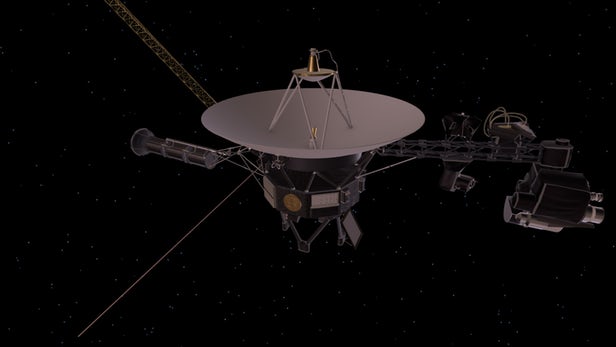Launched 42 years ago, the Voyager 1 and Voyager 2 space probes are now exploring the outer realms of our solar system. Sadly, the end of the mission is now firmly in sight, but NASA has a plan to keep the probes operational for as long as possible before their power finally runs out.
Source: Gizmodo
Voyager 1 and 2 were launched in 1977 within 16 days of one another. Both probes visited Jupiter and Saturn, but Voyager 2 was sent on a trajectory that saw it zip past Uranus and Neptune. Since then, the probes have journeyed increasingly farther into deep space, traveling at speeds approaching 56,000 kilometers per hour (35,000 miles per hour). The probes are now more than 18 billion kilometers (11 billion miles) away from Earth. Voyager 1, the farthest of the two, is so far away that a radio signal from Earth traveling at the speed of light requires 20 minutes to reach the probe.
Sadly, and like all good things, this historic mission will eventually come to an end. The probes are expected to keep working until the mid 2020s, after which time they won’t have enough power to supply their heaters. Eventually, the onboard components will freeze, turning the probes into two dead chunks of metal careening through space.
But while the end of the mission is inevitable, NASA is not going to let the probes go gentle into that good celestial void. As the agency noted in a recent press release, Voyager engineers are contemplating some adjustments intended to prolong the life of the probes to the greatest extent possible. NASA’s new “power management plan” is intended to keep the Voyager probes working such that scientific data can continue to be collected at the heliopause, the boundary between the solar wind (particles released by the Sun’s corona) and interstellar space.
Needless to say, it’s starting to get a bit chilly for the Voyagers, which run the risk of freezing so far from the Sun. A frozen fuel line, for example, would render their thrusters inoperable, making it impossible for the probes to orient their antennae and communicate with Earth. That’s why they are equipped with a power supply and some heating units, as NASA explains:
Each of the probes is powered by three radioisotope thermoelectric generators, or RTGs, which produce heat via the natural decay of plutonium-238 radioisotopes and convert that heat into electrical power. Because the heat energy of the plutonium in the RTGs declines and their internal efficiency decreases over time, each spacecraft is producing about 4 fewer watts of electrical power each year. That means the generators produce about 40% less than what they did at launch nearly 42 years ago, limiting the number of systems that can run on the spacecraft.
With the amount of power dwindling (the radioisotope thermoelectric generators aren’t expected to last much beyond 2025), NASA is having to decide which components get the juice required for the heaters, and which don’t. Accordingly, the agency’s new power management system considers “multiple options for dealing with the diminishing power supply on both spacecraft, including shutting off additional instrument heaters over the next few years,” notes NASA.
The situation with Voyager 2 is more urgent because it has more instruments requiring power. Recently, Voyager engineers decided to shut down the heater that warms its Cosmic Ray Subsystem (CRS). This instrument records information about the probe’s environment and how the heliosphere is interacting with the solar wind flowing in this region of space. Remarkably, Voyager 2’s CRS didn’t die—it’s still recording and returning data to Earth, even though it’s now operating at temperatures below those in which it was tested on Earth.
“It’s incredible that Voyagers’ instruments have proved so hardy,” said Voyager project panager Suzanne Dodd in the NASA press release. “We’re proud they’ve withstood the test of time. The long lifetimes of the spacecraft mean we’re dealing with scenarios we never thought we’d encounter. We will continue to explore every option we have in order to keep the Voyagers doing the best science possible.”
Other instruments, including devices that measure plasma and magnetic fields, are continuing to receive warmth from their heaters. At least for now.
Another important consideration are the probe’s thrusters, which are powered by hydrazine. These thrusters are critical to operations insofar as these thrusters, through their tiny pulses, rotate the spacecraft. Two years ago, NASA needed to re-orient Voyager 1, but it took more pulses than usual, and it required them to trigger a set of thrusters that hadn’t been used in 37 years. The episode showed that the Voyager thrusters are gradually weakening over time, and that a similar adjustment will have to be made on Voyager 2—a switch that’s expected to happen later this month.
But any little adjustment will help, as NASA tries to squeeze every last bit of life left in these historic probes, which are providing unprecedented data for scientific analysis.
1 comment
































1 Comment
Darren
July 12, 2019, 8:59 amOne of the engineers at work pointed out the time is wrong in this story.
Speed of light 299,792 km/s or 17,987,520 km / minute.
11,000,000,000 / 17,987,520 = 611.53 minutes
or
10.19 hours.
You got to love those engineers!
REPLY